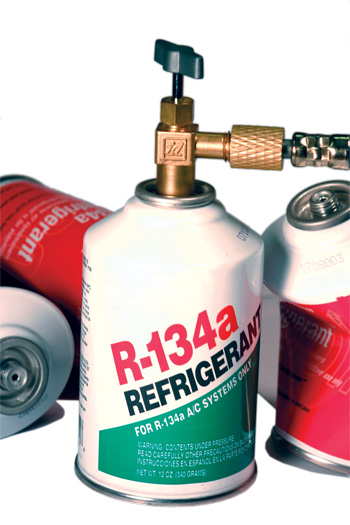Up until the early 1990s, R-12 refrigerant (Freon) was used in virtually all automotive A/C systems. It was an efficient refrigerant and relatively cheap. But the chlorine in R-12 was found to have a damaging effect on the earth’s protective ozone layer high in the atmosphere. So, starting in 1992, R-12 was gradually phased out and replaced with a new ozone-safe (no chlorine) R-134a refrigerant. All cars and light trucks made since 1995 use R-134.
 Many older vehicles that were originally equipped with R-12 A/C systems have been converted (retrofitted) to R-134a or other “approved” alternative refrigerants when they needed major A/C repairs. In many instances, the conversion requires nothing more than a change of refrigerant and compressor oil. On others, it may require a different compressor, hoses and seals. Such conversions are mostly history now, so the major emphasis today is on A/C leak repairs that cause refrigerant loss.
Many older vehicles that were originally equipped with R-12 A/C systems have been converted (retrofitted) to R-134a or other “approved” alternative refrigerants when they needed major A/C repairs. In many instances, the conversion requires nothing more than a change of refrigerant and compressor oil. On others, it may require a different compressor, hoses and seals. Such conversions are mostly history now, so the major emphasis today is on A/C leak repairs that cause refrigerant loss.
The refrigerant is the working fluid inside the A/C system. It provides a cooling effect when it changes “phase” and goes from a compressed high-pressure liquid to a low pressure vapor. The refrigerant is never used up but continually recycles inside a closed loop. It goes from the compressor to the condenser (the heat exchanger in front of the radiator that cools and condenses the refrigerant) to the evaporator (a second heat exchanger inside the HVAC unit where the refrigerant expands and cools air entering the passenger compartment), and then returns to the compressor to repeat the cycle over again.
The refrigerant should last the life of the vehicle, but over time, small amounts of refrigerant can escape from the system by seeping past compressor seals and hose connections. Leaks also may develop in the evaporator or condenser that allow refrigerant to escape. When the refrigerant charge gets low, it causes a drop in cooling performance. If too much refrigerant is lost, the A/C won’t cool at all.
The fix for poor cooling performance is to recharge the A/C system by adding refrigerant through the low-pressure service port on the suction hose that goes to the compressor while the engine is idling. The amount of refrigerant in the system is critical. It requires just the right amount of refrigerant: not too much and not too little. Most newer vehicles use a much lower refrigerant charge than older vehicles – as little as a pound or less in some applications.
Prior to recharging the A/C system with refrigerant, any leaks in the system should be found and fixed using UV leak detection dye or an electronic leak detector.
Also, if an A/C system has been opened to replace components (such as a compressor, hoses, condenser, accumulator or evaporator), the system must be purged of air using a high-vacuum pump before any refrigerant is added otherwise air will displace refrigerant resulting in poor cooling performance and noise. Residual moisture in the system also can form corrosive acids that can lead to component failures down the road. Vacuum purging removes the moisture along with the air. On older, high-mileage vehicles, the accumulator or receiver/drier should also be replaced to protect against moisture contamination.
Customers who are buying refrigerant may also need compressor oil. Different A/C systems require different types of PAG oil. Using the wrong oil may cause compressor problems, so be sure your customer gets the correct PAG oil for their vehicle.
In the years ahead, a new refrigerant called HFO-1234yf will gradually replace R-134a in new vehicles. There are only a couple of applications now but more are on the way. The new refrigerant’s cooling performance is similar to R-134a but it has a much lower Global Warming Potential (4 versus 1400 for R-134a) making it much more environmentally friendly.












